Unfortunately, not all items in a warehouse can be packed neatly into square boxes for handling. Moving unusual sizes and shapes is where sideloader forklifts come into their own.
Melissa Barnett looks at the niche market for this specialised equipment.
Although sales volumes have always been small, between 1%-5% of the worldwide forklift market, sideloaders have established themselves as the materials handling equipment of choice for unconventional loads.
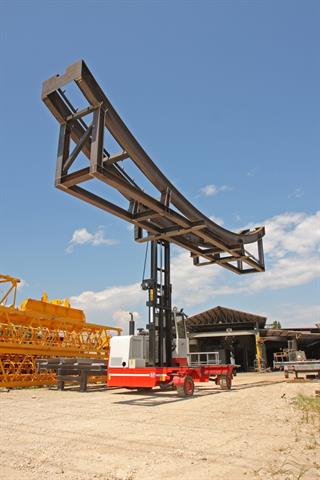 BP sideloader carrying steel frame |
Sideloaders are commonly used in the timber, glass, steel, aluminium, construction and aviation industries, as well as those industries producing unusual products such as windmill arms and mouldings - any industry, in fact, that produces a long, awkward or oversized item.
Sideloaders were first designed in the early 1950s by Henry Le Grande Lull of the Lull Manufacturing Company in response to a request from the United States Air Force. The concept was patented for commercial use but was not developed further until Lull manufacturing was taken over by the Baker Raulang company in 1959. Baker Raulang put the design into production and renamed it the Baker 'Traveloader'. Sideloaders were introduced to Europe in the late 1950s by Italian manufacturer Fiora and later B-P Battioni e Pagani, which pioneered its use in timber yards.
Sideloaders differ significantly from forward-moving, counterbalance forklifts by having their forks at the side of the machine. The operator drives the machine sitting in a cabin like a conventional forklift, while the lifting, loading and unloading functions are done by the mast at the driver's right-hand side. The load is usually transported lying on a wooden or metal deck, reducing stress, distortion and damage to the load. However, recent innovations to sideloader design have seen a variety of lifting accessories being developed.
The low deck and high cabin placed either forward or aft means the driver has an unobstructed view in front and behind. Sideloaders tend to operate in narrow-aisle situations and can often move between outside and inside environments.
Advantages in using sideloaders over conventional forklifts or reachstackers include faster travelling speeds, safer operating conditions because of clearer visibility and the ability to use available space more efficiently.
Sideloaders are frequently customised for use in very specific applications. Frederico Zanotti of Italian manufacturer B-P Battioni e Pagani explains that his company regularly manufactures attachments and options for specific clients, including beams, tilting arms, extenders and rollers that require handling loads of various forms, dimensions and weight.
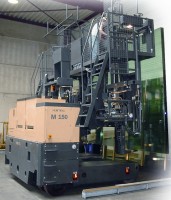 Hubtex M-series |
German manufacturer Hubtex has designed an attachment for its M-series multi-directional sideloader which uses suction caps to pick up large flat sheets of material. The vacuum attachments can be hydraulically raised to the vertical position for the sideloader to handle bulk packs of fibre cement board or plate glass, the latter weighing up to 20 tons. The arms can then be lowered for the machine to be used as an order picker.
Like others in the materials handling sector, sideloader manufacturers have had to diversify their product range to maintain relevance. Many, including Combilift, B-P, Hubtex, Omega and Votex-Bison, have developed four-way and multi-directional machines to accommodate ever-increasing demand for more efficient, space-saving equipment.
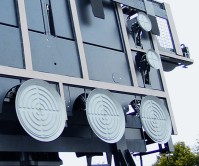 Hubtex M-series vacuum attachment |
Four-ways are three-wheel machines which can switch from sideloader to forklift mode, depending on what application the driver needs at the time. By using three wheels, the machine ensures better stability - especially on uneven ground. Multi-directional sideloaders use all four wheels as steering wheels, so they are able to move in any direction.
Martin McVicar, managing director of Combilift, explains that Combilft's four-way sideloader was developed after feedback from traditional sideloader users. "We found that users wanted a more manoeuvrable machine which could provide better storage density and block, whilst still able to work in their pre-existing aisle widths," he adds.
Combilift put its slogan "Customised Handling Solutions" to the test when it modified a Combilift C6000SL for Hillsborough, a steelstock warehouse in the UK. Hillsborough handles up to 20,000 tons of steel products a year in the form of steel plates, as well as 18 metre bundles of tubes and bars. Combilift customised the C6000SL by adding a wider-than-normal deck to prevent stock from bending and deck end-stops to prevent round stock such as tubes and pipes from rolling off.
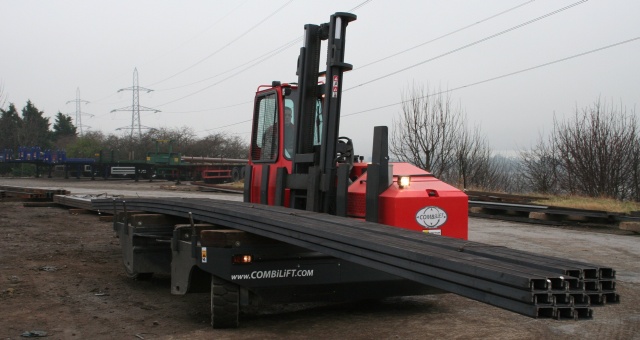 Combilift C6000SL |
Pipes, a particular speciality of sideloaders, are often stored in custom-built, cantilevered racks, so a number of manufacturers have come up with innovations to overcome the storage and safety issues when dealing with pipes. Combilift has further addressed this problem by lowering its machines' deck height to 850 mm for easier access to lower racks. This has had the added benefit of creating an extra 150 mm of storage space.
An early innovator, Canadian manufacturer Omega Lift's 4D Multiloader, was designed with a forkspread of 4.6 metre and a triple-stage mast height of 5.4 metres, ideal for manoeuvring long pipe loads into cantilevered racking while creating smaller aisle widths.
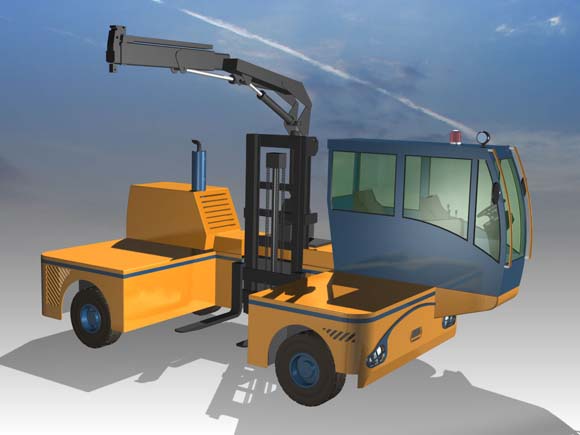 VKP ABF30Q car re-locator |
Sideloaders are unique in the materials handling world for the range of applications to which they can be adapted. Czech Republic manufacturer VKP has designed a sideloader which removes illegally parked cars. The ABF 30Q is designed to lift and remove cars or vans weighing up to three tons. The machine is fitted with forks which can be hydraulically adjusted to fit the axle size of the offending vehicle. The forks are slipped under the car which is then placed on the machine's deck. If a car needs to be removed from a row of vehicles, a hydraulic swivel arm, mounted on the mast, reaches in and picks up the car, which is then placed on the machine's deck.
In the 1980s and '90s, the big sideloaders lost ground to the stronger and more efficient reachstackers. Since then, Frederico Zanotti says, "the 15 ton and above market is limited to niche applications". "However, we are seeing an increase in demand for larger machines lately, particularly from the steel and fibreglass industries and from ship-builders," he adds
Conventional sideloaders, multidirectional and four-way sideloaders are available in sizes from 1 tonne to a 55 tons container handling sideloader manufactured by Fantuzzi SpA.
Fuel efficiency is always top of the requirements list for any materials handling user. All makes of sideloader are currently available in either electric, LPG or diesel.
Battioni recently conducted a comprehensive comparison between the efficiency and cost scales of a 5 tons electric and a 5 tons diesel hydrostatic sideloader and found that the operating and maintenance differences between the two for 1,500 working hours were about EUR10,000 (USD14,800) less for the 5 tons electric model.
Zanotti believes that electric sideloaders, given their increasing efficiency in outdoor terrains, comparable running costs, lower maintenance costs and zero emissions, will make them the better choice in the future. He also believes that an increasing demand for 10 tonne and above capacity machines for use indoors means that sideloader manufacturers will have to address the problem of designing heavier electric machines to maintain marketshare.
Sideloader manufacturers have embraced customer concerns for safety and improved efficiency. Votex-Bison, Omega and Chinese manufacturer Maximal have all incorporated on-board electronics to monitor speed and maintenance requirements.
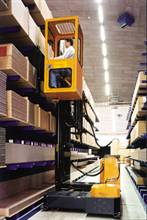 Votex-Bison Patriot |
Votex-Bison's four-way Patriot reduces travelling speed automatically if the load is lifted or steering sharply. It also has a touchscreen diagnostic control and warning system to monitor oil and battery levels.
Omega has incorporated a remote online diagnostic system in its 4DML which gives factory engineers access to the machine from anywhere in the world, at any time. The system allows programing changes to be uploaded and operating parameters such as steering and speed to be set.
Maximal's recently updated model, the FBT13-MJZ, now has on-site programming which can automatically store shelf height and location information, as well as a video display which allows the driver to see the shape and location of goods in the distance.
Because the sideloader market is so small and specialised, most in the industry feel that there has been little impact from the GFC. All have plans to continue investment in research and development and most are looking to expand into new markets in the future.
Newcomers are targeting Europe and the US, as well as emerging Asian economies, whilst established European dealers and manufacturers are looking to the emerging Eastern European markets and South America. In the words of Barry Su, spokesman for Maximal Forklifts, "new entrants stimulate existing manufacturers to be stronger. As the saying goes, 'where there is competition, there is progress'."